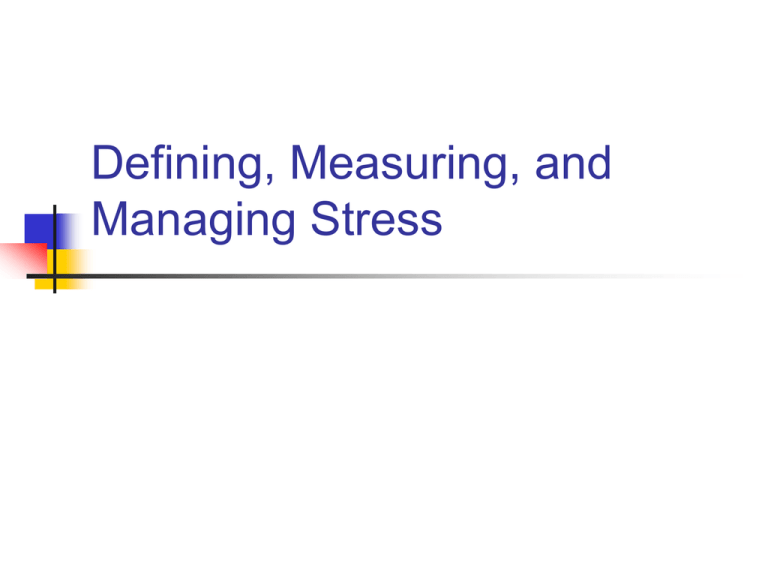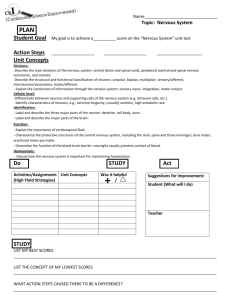Defining, Measuring, and Managing Stress
advertisement

Defining, Measuring, and Managing Stress The nervous system Neurons Synaptic Gap Neurotransmitters What are neurons? How do they transmit information? 4 Neurons Nerve cells ◦ Basic building blocks of the body’s information processing system. Made up of ◦ Dendrites ◦ Axons 5 Dendrites Receive information 6 Axon fibers Transmit information to other Neurons Muscles Glands 7 How do neurons communicate to other cells to influence our behavior? 8 Synapse (Synaptic gap) Chemical messengers (neurotransmitters) bridge the gap Rats in an enriched environment will increase their synapses. 9 Neurotransmitters Enable communication between neurons 10 Two major divisions of nervous system Central nervous system Peripheral nervous system What are the parts of your nervous system? What do these parts do? 12 Nervous system Central nervous system Brain and spinal column Peripheral nervous system Links central nervous system (spinal cord) to sense receptors, muscles and glands 13 Central Nervous system Brain and spinal column Severed spinal cord E.g. E.g. -Sally - knee jerk reaction without sensation of a tap on the knee Bill - No genital sensations, but has an erection when stimulated. 14 Peripheral Nervous System Sympathetic nervous system (Arousing) ◦ Increases heartbeat & blood pressure Parasympatheti c nervous system (Calming) 15 Peripheral nervous system Somatic nervous system Skeletal muscles Autonomic nervous system Sympathetic “Fight or flight” Mobilizes resources Parasympathetic Heart speeds up Blood vessels in skin contract Breathing increases Relaxation and normal functioning Increasing one, decreases the other Theories of stress General Adaptation Syndrome Lazarus’s view General adaptation syndrome (GAS) 1. Alarm Sympathetic nervous system starts 2. Resistance Adapts to stressor Diseases of adaptation Prepares for “Fight or flight” Ulcers Hypertension Cardiovascular disease Bronchial asthma 3. Exhaustion Lazarus’s View Interpretation (cognitive mediation) of event is more important than the event itself Person’s perception of the situation is critical Potential harm Threats Person’s ability to cope with them Lazarus’s View Stressor + Cognitive mediation = Stress Events do not produce stress - The person’s view of the situation produces the stress The “Definition of the situation” Measurement of stress Physiological Blood pressure Heart rate Galvanic skin response Respiration rate Self-report Used by most health psychologists Sources of stress Cataclysmic events PTSD - Posttraumatic stress disorder In 1/4 to 1/3 of individuals experiencing cataclysmic events Irrational events create more stress than natural disasters Sources of stress Occupation High demands & low control = stress Executive rat Strategies for coping with stress Social support Durkheim’s suicide study Personal control Internal locus of control Adopt best to stress External locus of control More personal control = better health Strategies for coping with stress Problem-focused coping Reduce stressor (change the situation) Best for good health Proactive coping Anticipating a problem and taking steps to avoid it Strategies for coping with stress Emotion-focused coping Manage emotions Meaning-focused coping Create personal and spiritual meaning Managing stress Relaxation training Progressive muscle relaxation Explanation = tense muscles Breathe deeply & exhale slowly Deep muscle relaxation exercises E.g. Tense and relax Can be used with biofeedback and hypnotic therapies Managing stress Cognitive behavior therapy Changing attitudes and behavior Beliefs Attitudes Thoughts Skills to change behavior Cognitive behavior therapy 1. Conceptualization stage Identify problems Educational 2. Skills acquisition and rehearsal stage Educational and behavior Increase coping skills E.g. assertiveness Practice Monitor “self-talk” 3.Application and follow-through Put skills into practice Emotional Disclosure James Pennebaker Writing or talking about traumatic events helps Emotional self-disclosure improves psychological and physical health E.g. writing letter Emotional disclosure vs. emotional expression Emotional disclosure Self- reflection Emotional expression Crying




